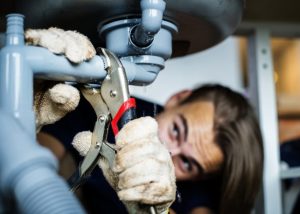What are your thoughts on Finding hidden leaks?

Early detection of dripping water lines can reduce a possible calamity. Some tiny water leakages might not be visible.
1. Take A Look At the Water Meter
Every home has a water meter. Examining it is a proven manner in which aids you find leakages. For beginners, switch off all the water sources. Make certain no one will certainly flush, use the tap, shower, run the washing machine or dish washer. From there, go to the meter and also watch if it will transform. Considering that nobody is utilizing it, there must be no activities. That suggests a fast-moving leakage if it moves. Also, if you find no changes, wait an hour or more and also inspect back again. This suggests you might have a sluggish leakage that can also be underground.
2. Check Water Intake
If you spot unexpected adjustments, despite your consumption being the same, it suggests that you have leakages in your plumbing system. An unexpected spike in your costs shows a fast-moving leakage.
A constant increase every month, even with the same behaviors, reveals you have a slow-moving leakage that's additionally gradually escalating. Call a plumber to completely examine your residential property, especially if you really feel a cozy location on your flooring with piping underneath.
3. Do a Food Coloring Examination
When it concerns water intake, 30% comes from bathrooms. Test to see if they are running appropriately. Decline specks of food shade in the storage tank as well as wait 10 mins. There's a leakage between the tank and dish if the color somehow infiltrates your bowl throughout that time without flushing.
4. Asses Outside Lines
Do not fail to remember to inspect your outdoor water lines too. Test faucets by attaching a yard hose. Needs to water seep out of the link, you have a loosened rubber gasket. Replace this and also guarantee all connections are tight. If you've got an automatic sprinkler, it will certainly aid get it expertly checked out and also maintained each year. One small leakage can lose tons of water and spike your water costs.
5. Examine the circumstance and also evaluate
Homeowners must make it a behavior to examine under the sink counters and even inside closets for any kind of bad odor or mold and mildew development. These 2 red flags suggest a leakage so timely focus is called for. Doing regular assessments, even bi-annually, can save you from a major problem.
Check for discolorations and deteriorating as the majority of pipelines and appliances have a life expectations. If you believe leaking water lines in your plumbing system, don't wait for it to escalate.
Early detection of dripping water lines can mitigate a potential calamity. Some little water leaks might not be visible. Examining it is a guaranteed means that helps you discover leakages. One little leakage can squander lots of water as well as spike your water costs.
If you presume dripping water lines in your plumbing system, don't wait for it to intensify.
WARNING SIGNS OF WATER LEAKAGE BEHIND THE WALL
PERSISTENT MUSTY ODORS
As water slowly drips from a leaky pipe inside the wall, flooring and sheetrock stay damp and develop an odor similar to wet cardboard. It generates a musty smell that can help you find hidden leaks.
MOLD IN UNUSUAL AREAS
Mold usually grows in wet areas like kitchens, baths and laundry rooms. If you spot the stuff on walls or baseboards in other rooms of the house, it’s a good indicator of undetected water leaks.
STAINS THAT GROW
When mold thrives around a leaky pipe, it sometimes takes hold on the inside surface of the affected wall. A growing stain on otherwise clean sheetrock is often your sign of a hidden plumbing problem.
PEELING OR BUBBLING WALLPAPER / PAINT
This clue is easy to miss in rooms that don’t get much use. When you see wallpaper separating along seams or paint bubbling or flaking off the wall, blame sheetrock that stays wet because of an undetected leak.
BUCKLED CEILINGS AND STAINED FLOORS
If ceilings or floors in bathrooms, kitchens or laundry areas develop structural problems, don’t rule out constant damp inside the walls. Wet sheetrock can affect adjacent framing, flooring and ceilings.
https://www.servicemasterbyzaba.com/blog/how-to-detect-water-leakage-in-walls/

As a passionate person who reads on Top leak detection hacks, I was thinking sharing that excerpt was a good idea. Kindly take the opportunity to share this blog post if you enjoyed reading it. I praise you for your time. Kindly come by our blog back soon.